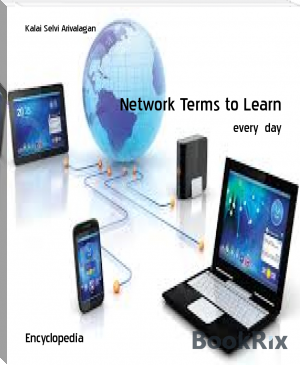Network Terms to Learn, Kalai Selvi Arivalagan [books to read in a lifetime .TXT] 📗

- Author: Kalai Selvi Arivalagan
Book online «Network Terms to Learn, Kalai Selvi Arivalagan [books to read in a lifetime .TXT] 📗». Author Kalai Selvi Arivalagan
Data Encryption Standard
The data encryption standard (DES) is a common standard for data encryption and a form of secret key cryptography (SKC), which uses only one key for encryption and decryption. Public key cryptography (PKC) uses two keys, i.e., one for encryption and one for decryption.
Machine Learning Operations
Machine learning operations (MLOPs) is a set of practices that combines developing and maintaining machine learning (ML) seamlessly. The goal is to establish reliable communication and collaboration between data scientists and machine learning operations professionals in order to properly manage and shorten an artificial intelligence (AI) product’s lifecycle. The three main components of MLOps are machine learning, DevOps (IT), and data engineering. It achieves that by implementing automation as often as possible, settling on the balance between improving product quality and meeting business and market requirements.
MLOps works on the same principles that run DevOps. In addition to the software developers (Devs) and IT operations teams, MLOps includes data scientists and ML engineers. The result is a continuous production loop that starts with collecting data and modeling in the MLOps segment. The workflow then proceeds to the devs, where they handle the product’s verification and packaging before sending it to the IT operations team to release, configure, and monitor the result. The loop continues as the feedback is used to plan and create a new update to the machine, going back to data experts.
MLOps is able to produce noticeable results because it bridges the gap between data scientists and ML engineers, and devs and IT teams. MLOps was developed with the knowledge that not all data scientists and ML engineers are experienced in programming languages and IT operations. But instead of older models, where every section in ML development is independent, MLOps creates a continuous feedback loop between the three departments, enabling a faster development cycle and higher product quality, all whilst allowing professionals to focus solely on what they know best instead of having to learn skills on the opposite end of the spectrum.
Massively Multiplayer Online Role-Playing Game
A massively multiplayer online role-playing game (MMORPG) is a video game that takes place in a persistent state world (PSW) with thousands, or even millions, of players developing their characters in a role-playing environment. The virtual world in which the game takes place is never static. Even when a player is logged off, events are occurring across the world that may impact the player when he or she logs in again.
First Person Shooter
A first person shooter (FPS) is a genre of action video game that is played from the point of view of the protagonist. FPS games typically map the gamer's movements and provide a view of what an actual person would see and do in the game.
A FPS usually shows the protagonist's arms at the bottom of the screen, carrying whatever weapon is equipped. The gamer is expected to propel his avatar through the game by moving it forward, backward, sideways and so on using the game controller. Forward movements of the controller result in the avatar moving forward through the scenery, usually with a slight left-right rocking motion to properly simulate the human gait. In order to increase the level of realism, many games include the sounds of breathing and footsteps in addition to the regular sound effects.
FPS games can be played in two general modes, mission or quest mode and multiplayer mode. The mission mode is usually the default mode for a single player. It usually involves the player battling through progressively harder game levels towards some ultimate goal. The multiplayer mode involves multiple gamers participating via a network and playing in a shared game environment. The multiplayer mode can take many forms, including:
Deathmatches
Capture the flag
Team deathmatch
Search and destroy
Base (a.k.a assault or headquarters)
Last man standing
Learn More
Grinding
Grinding refers to the playing time spent doing repetitive tasks within a game to unlock a particular game item or to build the experience needed to progress smoothly through the game. Grinding most commonly involves killing the same set of opponents over and over in order to gain experience points or gold. Although other game genres require some grinding, role-playing games (RPG) – specifically massively multiplayer online role-playing games – are the most notorious for requiring this type of time investment from players. A game level at which a lot of grinding is required may be called a treadmill level.
Emergent Gameplay
Emergent gameplay is a game design term that refers to video game mechanics that change according to the player's actions. Emergent gameplay includes a number of relatively simple decisions that a player must make, the sum of which lead to more complex outcomes. Emergent gameplay can also be created by adding multiple players to the same game environment and having their individual actions impact the overall game narrative. Similarly, more complex artificial intelligence capable of impacting the storyline in unpredictable ways can be used in lieu of additional players.
Massively Multiplayer Online Game
A massively multiplayer online game (MMOG) refers to videogames that allow a large number of players to participate simultaneously over an internet connection. These games usually take place in a shared world that the gamer can access after purchasing or installing the game software. The explosive growth in MMOGs has prompted many game designers to build online multiplayer modes into many traditionally single-player games.
Secure File Transfer Protocol
Secure File Transfer Protocol (SFTP) is a file protocol for transferring large files over the web. It builds on the File Transfer Protocol (FTP) and includes Secure Shell (SSH) security components. Secure Shell is a cryptographic component of internet security. SSH and SFTP were designed by the Internet Engineering Task Force (IETF) for greater web security. SFTP transfers files security using SSH and encrypted FTP commands to avoid password sniffing and exposing sensitive information in plain text. Since the client needs to be authenticated by the server, SFTP also protects against man-in-the-middle attacks.
SFTP can be handy in all situations where sensitive data needs to be protected. For example, trade secrets may not be covered by any particular data privacy rule, but it can be devastating for them to fall into the wrong hands. So a business user might use SFTP to transmit files containing trade secrets or other similar information. A private user may want to encrypt his or her communications as well. This term is also known as Secure Shell (SSH) File Transfer Protocol.
Cryptomining
Cryptomining is the process of validating cryptocurrency transactions. The foundation of cryptocurrencies is distributed public ledgers that record all financial transactions. The records are saved in the form of blockchains. Each transaction is linked to the subsequent transaction creating a chain of records. The records are linked using cryptographic hashes.
Because the ledger is public, a record needs to be validated before being added to the ledger. Otherwise, it would be too easy to forge fraudulent payments. Cryptocurrencies use Proof-of-Work (PoW) as a security measure.
In order to post a transaction to the ledger, a problem that is difficult to solve, but easy to verify must be computed. The problems are computationally complex and require brute force to solve. A network of computers will compete to solve the problem first. This process is called cryptomining.
The computer that solves the problem first earns the right to post the transaction to the ledger. The goal is to make the cost of solving the complex problem higher than the gain of posting a fraudulent transaction. The benefit to the cryptominer is that for every transaction posted, the winner receives a small reward. The reward is often a combination of a fee associated with the transaction and newly created cryptocurrency.
Integrated Services Digital Network (ISDN)
Integrated Services Digital Network (ISDN) is a set of communication standards for digital telephone connection and the transmission of voice and data over a digital line, and is a development of the plain old telephone service (POTS). These digital lines are commonly telephone lines and exchanges established by the government. They are used instead of the traditional circuits of the classic switched telephone network since they can integrate data and speech on the same line. Before ISDN, it was not possible for ordinary telephone lines to provide fast transmission over a single line.
ISDN was designed to run on digital telephone systems that were already in place. As such, it meets telecom’s digital voice network specifications. Originally, it was largely used by businesses that needed to support many desk phones and fax machines. However, it took so long for ISDN to be standardized that it was never fully deployed in the telecommunications networks it was intended for.
ISDN was formally standardized in 1988 and gained some significant popularity in the 1990s as a faster (128 Kbps) alternative to the 56 Kbps dial-up connection for internet access. However, as soon as telecom companies switched from analog to digital infrastructures, modern long-distance networking and broadband internet technologies eventually made it an obsolete technology.
Deep Learning
Deep learning is an iterative approach to artificial intelligence (AI) that stacks machine learning algorithms in a hierarchy of increasing complexity and abstraction. Each deep learning level is created with knowledge gained from the preceding layer of the hierarchy.
The first layer of a deep image recognition algorithm, for example, might focus on learning about color patterns in training data, while the next layer focuses on shapes. Eventually, the hierarchy will have layers that focuses on various combinations of colors and shapes, with the top layer focusing on the actual object being recognized.
Deep learning is currently the most sophisticated AI architecture in use today. Popular deep learning algorithms include:
Convolutional neural network - the algorithm can assign weights and biases to different objects in an image and differentiate one object in the image from another. Used for object detection and image classification.
Recurrent neural networks - the algorithm is able to remember sequential data. Used for speech recognition, voice recognition, time series prediction and natural language processing.
Long short-term memory networks - the algorithm can learn order dependence in sequence prediction problems. Used in machine translation and language modeling.
Generative adversarial networks - two algorithms compete against each other and use each other's mistakes as new training data. Used in digital photo restoration and deepfake video.
Deep belief networks - an unsupervised deep learning algorithm in which each layer has two purposes: it functions as a hidden layer for what came before and a visible layer for what comes next. Used in healthcare sectors for cancer and other disease detection.
FileMaker Pro
FileMaker Pro is a cross-platform relational database application that is currently being marketed as a low-code/no-code (LCNC) database management system (DBMS) and rapid application development (RAD) software development tool. Data can be easily exported and imported to and from FileMaker Pro, and the graphical user interface (GUI) is designed to help non-technical line of business (LOB) professionals easily search, filter and sort specific data sets.
Each file in a FileMaker Pro database can consist of multiple tables, layouts, fields, menu sets, scripts, functions, logical relationships, calculations and embedded multimedia objects. Data in one table can be linked to data in other tables and multiple views for each table can easily be created, saved and shared. In the technology marketplace, FileMaker's competitors include MySQL, Libre Office Space and Zoho. It's possible to connect FileMaker to these other database systems by using a RESTful API called Claris Connect.
Firmware
Firmware is a type of software that is etched directly into a piece of hardware. It operates without going through APIs, the operating system, or device drivers—providing the needed instructions and guidance for the device to communicate with other devices or perform a set of basic tasks and functions as intended. Without firmware, the most basic of devices would not function. That is why it is often stored on a Read-Only Memory (ROM) chip, ensuring it does not get





Comments (0)